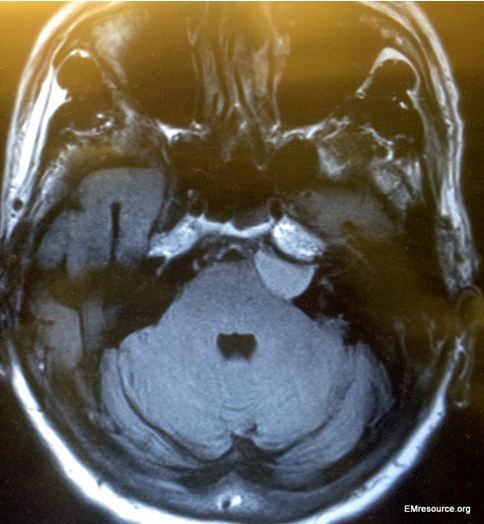- Clinical Technology
- Adult Immunization
- Hepatology
- Pediatric Immunization
- Screening
- Psychiatry
- Allergy
- Women's Health
- Cardiology
- Pediatrics
- Dermatology
- Endocrinology
- Pain Management
- Gastroenterology
- Infectious Disease
- Obesity Medicine
- Rheumatology
- Nephrology
- Neurology
- Pulmonology
Cerebello-pontine Angle Tumor
Signs and symptoms may raise suspicion for a posterior circulation stroke.

A 68-year-old man presents to the emergency department after 4 days of constant and slowly progressive ataxia and possibly some intermittent double vision. He denies vertigo, change in hearing, headache or ear pain, drug or alcohol use or other complaints. He has a history of hypertension but denies any other past medical history. His only medications are aspirin, HCTZ, and potassium.
Physical examination shows normal vitals signs. Examination of the head and neck reveals no facial weakness or nystagmus and normal eye motion. Tympanic membranes are clear and there is no vesicular rash. The heart is regular without murmur and the lungs are clear. The neurologic exam is essentially normal, including cranial nerves, except for a mildly positive Romberg sign.
An MRI of the brain is performed (see results in the Figure; click image to enlarge)
What diagnosis does the brain MRI reveal?
Answer: Cerebello-pontine angle tumor
The initial concern was for posterior circulation stroke, though this rarely presents with isolated ataxia. The MRI fortunately shows no cerebellar stroke or bleed, but there is a mass noted at the left cerebello-pontine angle (CPA). This is most likely an acoustic neuroma. The patient had a stable gait and wanted to go home so was discharged with neurosurgical follow-up.
Cerebello-pontine angle (CPA) tumors, also known as acoustic neuromas, develop from abnormal growth of Schwann cells which myelinate the eighth cranial nerve. Since the tumors usually involve the vestibular rather than acoustic branch of cranial nerve and they are not actually nerve tumors, a more accurate term would be a vestibular Schwannoma. The initial symptom of a CPA tumor is usually unilateral hearing loss, but as this is gradual and often a part of aging, the diagnosis may be missed until more advanced signs and symptoms develop such as ataxia, or unilateral facial numbness or weakness. (See Table below for details.)
CPA tumors are usually diagnosed by brain imaging, with MRI being the test of choice. Treatment involves surgery and or radiation therapy followed by rehabilitation with the use of hearing aids or other supports. This patient chose to pursue radiation with a gamma knife to avoid surgery.
Table.
Click image for more information.
